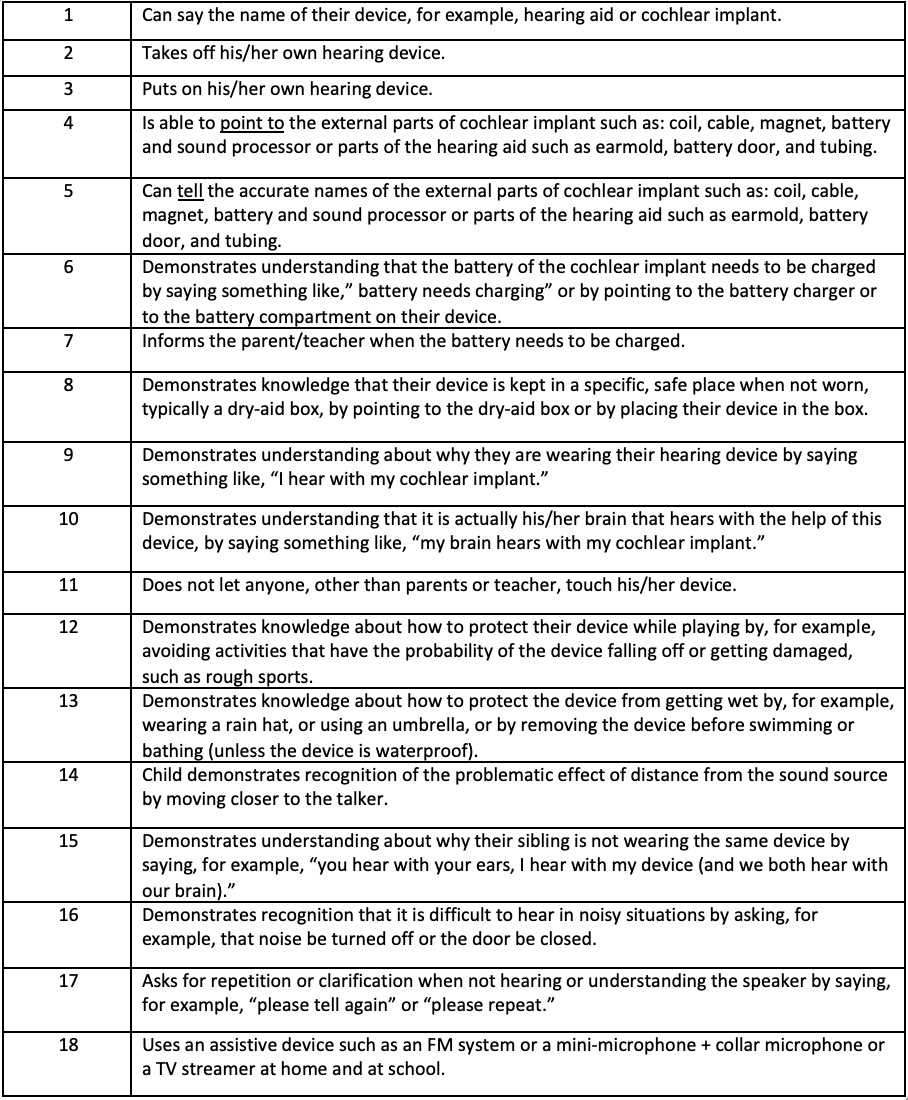Written By: Carol Flexer and Ritu Nakra
Many research papers report that children with hearing loss, when diagnosed and enriched with auditory language at a very young age, are able to achieve age-appropriate spoken language communication just like their peers with typical hearing. However, research also states that too many children with hearing loss lag behind in terms of social integration and executive functioning. Social and emotional development emanates from self-confidence and the ability to communicate ideas and feelings. Is there an early missing link in the development and maturation of self-advocacy skills? Are we teaching these skills too late and expecting too little from our children?
What is self-advocacy?
Self-advocacy means “the action of representing oneself or one’s views or interests.” Being able to do things independently affords a child a sense of purpose and worthiness. Self-advocacy helps children gain awareness of their own personal preferences, strengths, interests, potential, and challenges. Notably, self-advocacy enhances a child’s executive function by teaching them the art of consideration of multiple options after calculating the consequences of their actions.
How do we know there may be a problem with very young children developing self-advocacy skills?
We initially realized the extent of the lack of knowledge of basic self-advocacy skills through informal conversations with parents. Conversations revealed that while their very young children could appropriately identify a picture of an elephant and point to its body parts, they did not know the name of their cochlear implant (they called it a machine, device etc.) and could not point to its various components.
To gain a better understand of the scope and nature of the problem, we administered a Google Survey about young-children’s self-advocacy knowledge to a group of 30 families whose children were enrolled in an Auditory-Verbal early intervention program across India. All children were between the chronological ages of 2 and 6 years with a minimum hearing age of 6 months. The aim of this survey was to understand if young children with hearing loss had learned basic self-advocacy skills, and if they had, at what ages had those skills been developed. Knowledge of 18 basic skills was explored, including knowledge about the device, care of the device and social communication skills. Figure 1 displays an example of a survey question.
Figure 1: Sample of a Survey Question

Results
As seen in Figure 1, 47 percent of the children had no idea where their cochlear implant or hearing aid was kept once it was removed from their head.
The survey also revealed that children who knew something about noise were between 4.5 to 5.0 years of age. In fact, 53.6 percent of these children didn’t recognize the problematic effect of noisy situations, and didn’t know how to seek help for noise to be reduced or turned off. Those few children who could ask for help managing a noisy situation were about 5.0 years old. These results were very troubling because noisy situations need to be addressed early-on or they can become disastrous barriers to the reception of auditory information and to social inclusion for children with hearing loss.
Another question revealed that 57 percent of the children lacked language for seeking clarification or repetition if they didn’t understand the information given, and those who were able to do so were between 5.0 to 5.5 years old. And 75 percent of these children were not using assistive devices (remote microphones) in their schools or at home, and those few who did were between 4.0 to 4.5 years.
Importantly, only one child knew that it is actually the brain that hears with the help of the device. Even very young children can be taught that understanding the meaning of auditory information occurs in their brain, not in their ears. Our sensory organs, such as ears, eyes, and nose, capture different types of environmental information and send that information to the brain in the form of neural impulses. Through experience, practice, exposure and language, the brain grows neural connections resulting in the child learning the meaning of the environmental information. The only purpose of wearing hearing aids or cochlear implants is to capture and deliver auditory information to the brain for the growth of neural connections and subsequent knowledge. If the cochlear implant or hearing aid is not worn, the child’s brain is deprived of information and the child’s learning is compromised. So, even a very young child can be taught to say something like, “my brain hears with my cochlear implant.” The parent can, in the course of daily routines, often say something like, “your lovely brain is learning so much when you wear your cochlear implant (or hearing aid).”
Our survey concluded that due to lack of awareness in families about the importance of developing/teaching self-advocacy skills at a very young age, these children showed delays in developing these skills with respect to their chronological as well as hearing ages. The ultimate aim of any intervention process is the intellectual, social, physical and emotional integration of the child in our society. The child, even a young child, needs to feel confident and should be able to deal with situations that are in his/her daily routine. Lack of self-advocacy skills can lead to a child becoming vulnerable to bullying or teasing, and may make it more difficult to join group discussions and social gatherings.
What is one possible solution?
By reviewing the literature, there seemed to be a general consensus about which beginning self-advocacy skills should be learned and displayed. Subsequently, we identified 18 behaviors. We worked with a graphic designer and generated picture cartoons of children to confidently illustrate each concept, drawn on 18 separate training cards. We believed these self-advocacy behaviors could be easily learned during activities of daily living because all involved social involvement with much natural repetition. See Table 1 for a listing of these behaviors. See Figure 2 to view two sample training cards.
Table 1: List of 18 Beginning Self-Advocacy Skills on Training Cards

Figure 2: Examples of Two Training Cards


Parent On-Line Training
Thirty families volunteered to participate in the self-advocacy training process, including pre- and post-testing. All families were enrolled in Auditory-Verbal, family-focused, early intervention programs across India with desired outcomes of listening and spoken language for their children. All contact was via telepractice during this time of COVID. Once the 18 self-advocacy training cards were developed and ready to download, three 90-minute training webinars were held with smaller group of parents. Each group, comprised of 10 families to allow for discussion and questions, received one training webinar. The webinars began with the delivery of information about self-advocacy, executive function, social engagement, and social integration. The importance of teaching the child self-advocacy skills at a very young age, from the very start of intervention, was explained and emphasized. The materials were shared in English and Hindi. The parents downloaded the cards to their tablets or phones and were taught how to use them. After the training webinars, the families had one month to implement these self-advocacy skills at home, using the cards, and then to generalize self-advocacy concepts into their daily routine conversations with their children. After one month, parents shared home videos taken on their phones of their children using these new self-advocacy skills.
How do we know the cards provide effective guidance to parents?
A post-survey was conducted evaluating the same 18 skills. Results showed that the children improved in all self-advocacy areas. In addition, 90 percent of the families thought the role of on-line training and use of the cards was important or very important for the facilitation of self-advocacy skills in their young children, and all were satisfied or very satisfied with the on-line training and use of cards in expanding their knowledge and daily practice of self-advocacy behaviors. Most importantly, their home videos showed the integration of self-advocacy skills into daily living. For example, when asked what she should do when going out in the rain, one 4-year-old child replied that she could use an umbrella or wear a hat because she needed to protect her cochlear implant from getting wet.
External Verification
We conducted a webinar for professionals on September 18, 2020, about this topic of beginning self-advocacy skills in very young children. During this live webinar that was attended by about 138 people from 30 different countries, several polling questions were asked. The results of the online polls confirmed we are on the right track with parent training of self-advocacy and use of training cards.
Poll 1 to Professionals:
Do most families know specific self-advocacy skills to teach to their very young children with hearing loss, yes or no?
Result: 98 percent of webinar attendees indicated that families do not know specific skills to teach to their children.
Poll 2 to Professionals:
In your opinion, how important is it for professionals to include self-advocacy information and training in their family-focused therapy plans for very young children with hearing loss? Options ranged from not at all important to extremely important.
Result: 95 percent of webinar attendees agreed that including self-advocacy information and training in their family-focused therapy plans for very young children with hearing loss, is moderately to extremely important.
Due to early diagnosis of hearing loss, children and their families are starting intervention/enrichment very early, often in infancy, and we need to include the teaching of self-advocacy skills right from the beginning. This new generation of parents (and their children) are techno-savvy and hands-on friendly with managing technology. They are certainly capable of learning about and taking responsibility for their cochlear implants, hearing aids and remote microphone technologies.
We used to wait until grade school to talk with teachers and classmates about technology and hearing loss, and even then, parents often did the talking rather than the child. The goal, today, is to have even a very young child speak for themselves as early as possible.
The professional’s role of informing and guiding the family is critical in this initial self-advocacy process. Parents appear very willing to explain self-advocacy skills to their young children, but unless the parent is informed and coached to start early, the parent might think the child is too young and inexperienced to learn about and comprehend these concepts. Once the parent understands and observes that the child can learn self-advocacy concepts and speak up for themselves, the parent becomes motivated to continue the process.
Links for Downloading the 18 Training Cards
The cards are free and can be downloaded in English or Hindi. The cards also are in the process of being translated into other Indian regional languages. Our goal is to provide materials that offer parents accessible information about what and how to teach their very young children about self-advocacy.
- Resource Section of AVTAR (Auditory-Verbal Trainer and Resources) mobile application Free download at avtarapp.com/livesession
- Google Play Store: https://play.google.com/store/apps/details?id=com.MIPL.Avtar
- App store: IOS Link: https://apps.apple.com/in/app/avtar-app/id1462413057
- Hear Me Speak – hearmespeak.in
- VConnect Foundation, resource section – vconnectfoundation.org
Bios
 Carol Flexer, PhD, CCC-A, LSLS Cert. AVT, received her doctorate in audiology from Kent State University in 1982. She is a distinguished professor emeritus of audiology at the University of Akron. An international lecturer in pediatric and educational audiology and author of more than 155 publications including 17books, Dr. Flexer is a past president of the Educational Audiology Association, the American Academy of Audiology, and the AG Bell Academy for Listening and Spoken Language.
Carol Flexer, PhD, CCC-A, LSLS Cert. AVT, received her doctorate in audiology from Kent State University in 1982. She is a distinguished professor emeritus of audiology at the University of Akron. An international lecturer in pediatric and educational audiology and author of more than 155 publications including 17books, Dr. Flexer is a past president of the Educational Audiology Association, the American Academy of Audiology, and the AG Bell Academy for Listening and Spoken Language.
 Ritu Nakra, B.Sc (Hons) Physics, B.Ed (H.I.), LSLS Cert. AVT, is a parent of a child with hearing loss. She also is a director of Hear Me Speak, an early intervention center based in Delhi; founder of AVTAR mobile application and online session portal for parents and professionals; and co-founder of Online AVT. Ritu Nakra has mentored numerous professionals and helped establish early intervention centers across India, such as Listening Ears, Tara Foundation, and Jammu.
Ritu Nakra, B.Sc (Hons) Physics, B.Ed (H.I.), LSLS Cert. AVT, is a parent of a child with hearing loss. She also is a director of Hear Me Speak, an early intervention center based in Delhi; founder of AVTAR mobile application and online session portal for parents and professionals; and co-founder of Online AVT. Ritu Nakra has mentored numerous professionals and helped establish early intervention centers across India, such as Listening Ears, Tara Foundation, and Jammu.
References – For Additional Information
Ambrose, S.E., Appenzeller, M., & DesJardin, J.L. (2020). Evaluating self-efficacy in parents of children with hearing loss. The Hearing Journal, 73(9), 35-36.
Benitez-Barrera, C. R., Angley, G. P., & Tharpe, A. M. (2018). Remote microphone system use at home: Impact on caregiver talk. Journal of Speech, Language and Hearing Research, 61, 399–409.
Ching, T. Y. C., Dillon, H., Leigh, G., & Cupples. L. (2018). Learning from the longitudinal outcomes of children with hearing impairment (LOCHI) study: Summary of 5-year findings and implications. International Journal of Audiology, 57(S-2), S-105–S-111.
Cole, E. & Flexer, C (2020). Children with hearing loss: Developing listening and talking birth to six, Fourth Edition. San Diego, CA: Plural Publishing.
Estabrooks, W., Morrison, H.M., & MacIver-Lux, K. (2020). Auditory-verbal therapy: Science, research, and practice. San Diego, CA: Plural Publishing.
Hearing First Website. https://www.hearingfirst.org/ (Downloaded September 25, 2020).
Kral, A. (2013). Auditory critical periods: A review from system’s perspective. Neuroscience, 247, 117–133.
Kronenberger, W.G., Xu, H., & Pisoni, D.B. (2020). Longitudinal development of executive functioning and spoken language skills in preschool-aged children with cochlear implants. Journal of Speech, Language, and Hearing Research, 63, 1128-1147.
Madell, J. R., Flexer, C., Wolfe, J., & Schafer, E. C. (2019). Pediatric audiology: Diagnosis, technology and management (3rd ed.). New York, NY: Thieme Medical Publishers, Inc.
Pichora-Fuller, M.K., & Phillips, N. (2017). Tackling the toll of hearing loss on executive function. The ASHA Leader, 22(7), 6-8.
Rhoades, E.A., & Duncan, J. (2017). Auditory-verbal practice: Family-centered early intervention, 2nd ed. Springfield, IL: Charles C. Thomas LTD.
Success for Children with Hearing Loss website: Self Advocacy. https://successforkidswithhearingloss.com/for-professionals/self-advocacy-skills-for-students-with-hearing-loss/ (Downloaded September 25, 2020)

